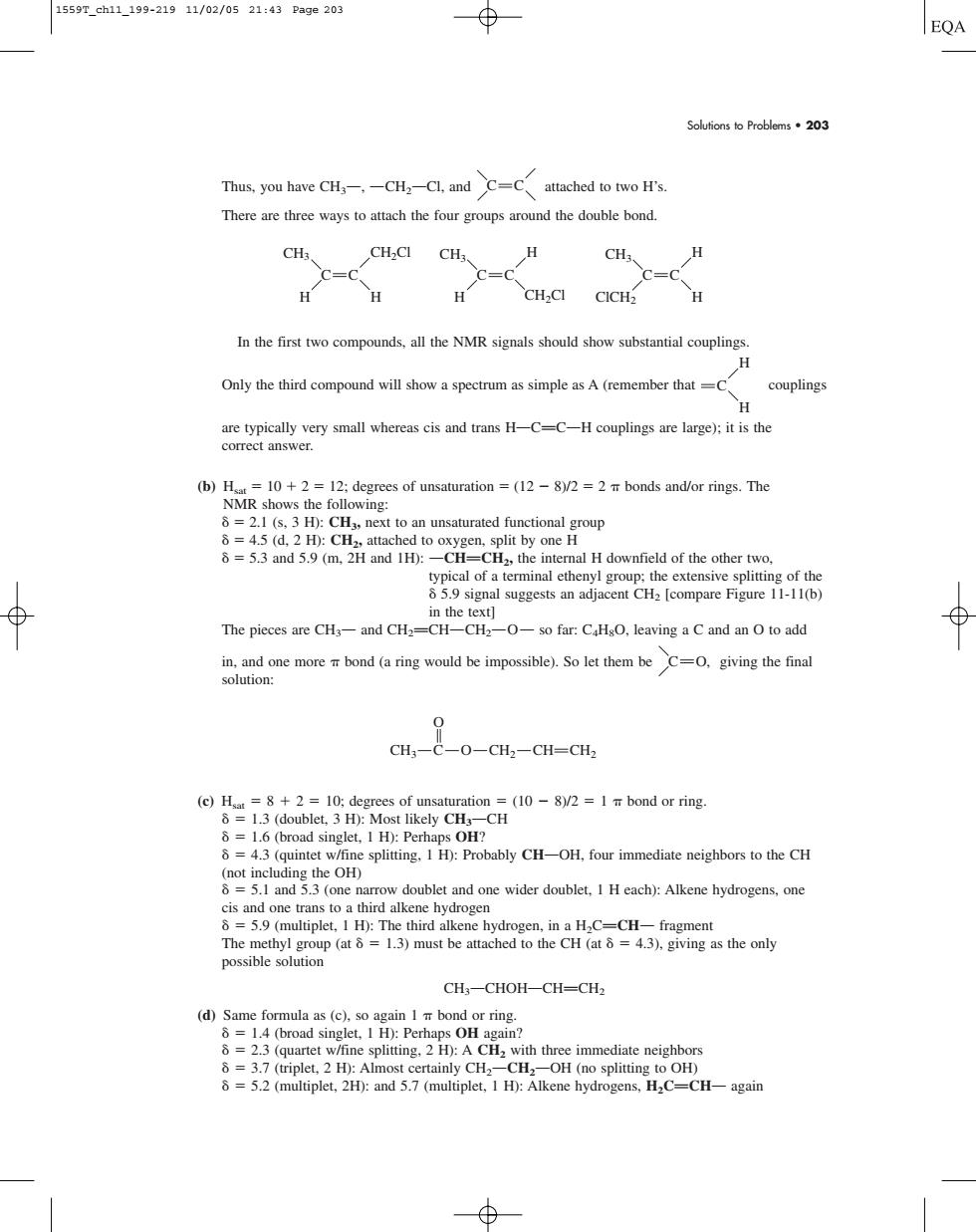正在加载图片...

1559r.ah11.199-21911/02/0521:43Page203 Solutions o Problems203 Thus,you have CH--CHa-Cl,and C=C attached to two H's There are three ways to attach the four groups around the double bond. CH C=C C=C H CH-CI CICH c-C-H In the first two compounds,all the NMR signals should show substantial couplings. Only the third compound will show a spectrum as simple as A (remember that =C couplings H are typically very small whereas cis and trans H-C-C-H couplings are large):it is the correct answer (b)H =2.1 (s,3H):CH,next to an unsaturated functional group al H downfield of the ypical of a terminal ethenvl the 65.9 signal suggests an adjacent CHa [compare Figure 11-11(b) --so far:CHO.leaving a Cand an O to add CH3-C-O-CH2-CH=CH2 =16(ho kely CHs CH bond or ring 8=4.3 (quintet w/fi e splitting.I H):Probably CH-OH,four immediate neighbors to the CH edoublct and oe ider doblct.Heach):Alkeme ydrognse cis and one trans to a third alkene hydrogen 7hc9 4.3)fragme as the only CH一CHOH-CH=CH (d)Same formula as (c).so again I bond or ring. 37(uriplet.2 H):Almost ce ertainly Ch H =5.2 (multiplet.2H):and 5.7 (multiplet,1 H):Alkene hydrogens.HC-CH-againSolutions to Problems • 203 Thus, you have CH3O, OCH2OCl, and attached to two H’s. There are three ways to attach the four groups around the double bond. In the first two compounds, all the NMR signals should show substantial couplings. Only the third compound will show a spectrum as simple as A (remember that couplings are typically very small whereas cis and trans HOCPCOH couplings are large); it is the correct answer. (b) Hsat 10 2 12; degrees of unsaturation (12 8)/2 2 bonds and/or rings. The NMR shows the following: 2.1 (s, 3 H): CH3, next to an unsaturated functional group 4.5 (d, 2 H): CH2, attached to oxygen, split by one H 5.3 and 5.9 (m, 2H and 1H): OCHPCH2, the internal H downfield of the other two, typical of a terminal ethenyl group; the extensive splitting of the 5.9 signal suggests an adjacent CH2 [compare Figure 11-11(b) in the text] The pieces are CH3O and CH2PCHOCH2OOO so far: C4H8O, leaving a C and an O to add in, and one more bond (a ring would be impossible). So let them be giving the final solution: (c) Hsat 8 2 10; degrees of unsaturation (10 8)/2 1 bond or ring. 1.3 (doublet, 3 H): Most likely CH3OCH 1.6 (broad singlet, 1 H): Perhaps OH? 4.3 (quintet w/fine splitting, 1 H): Probably CHOOH, four immediate neighbors to the CH (not including the OH) 5.1 and 5.3 (one narrow doublet and one wider doublet, 1 H each): Alkene hydrogens, one cis and one trans to a third alkene hydrogen 5.9 (multiplet, 1 H): The third alkene hydrogen, in a H2CPCHO fragment The methyl group (at 1.3) must be attached to the CH (at 4.3), giving as the only possible solution CH3OCHOHOCHPCH2 (d) Same formula as (c), so again 1 bond or ring. 1.4 (broad singlet, 1 H): Perhaps OH again? 2.3 (quartet w/fine splitting, 2 H): A CH2 with three immediate neighbors 3.7 (triplet, 2 H): Almost certainly CH2OCH2OOH (no splitting to OH) 5.2 (multiplet, 2H): and 5.7 (multiplet, 1 H): Alkene hydrogens, H2CPCHO again C O CH3 O CH2 CH CH2 C O, C H H C C CH CH2Cl 3 H H C C CH2Cl CH3 H H C C ClCH2 CH3 H H C C 1559T_ch11_199-219 11/02/05 21:43 Page 203��